|
1999-2004 (Return to Web Text-ures) |
Click Here to return to Birds Every Child Should Know Content Page Click Here to return to last Chapter |
 (HOME) |
|
1999-2004 (Return to Web Text-ures) |
Click Here to return to Birds Every Child Should Know Content Page Click Here to return to last Chapter |
 (HOME) |
|
CHAPTER III
A GROUP OF LIVELY SINGERS HOUSE WREN CAROLINA WREN MARSH WREN BROWN THRASHER CATBIRD MOCKINGBIRD THE HOUSE WREN IF YOU want some jolly little neighbours for the summer, invite the wrens to live near you year after year by putting up small, one-family box-houses under the eaves of the barn, the cow-shed, or the chicken-house, on the grape arbour or in the orchard. Beware of a pair of nesting wrens in a box nailed against a piazza post: they beat any alarm clock for arousing the family at sunrise. Save the starch boxes, cover them with strips of bark, or give them two coats of paint to match the building they are to be nailed on. Cut a hole that you have marked on one end of each box by drawing a lead pencil around a silver quarter of a dollar. A larger hole would mean that English sparrows, who push themselves everywhere where not invited, would probably take possession of each house as fast as you nailed it up. Of course the little one-roomed cottages should have a number of small holes bored on the sides near the top to give the wrens plenty of fresh air. Have the boxes in place not later than the first of April-then watch. Would it not be a pity for any would-be tenants to pass by your home because they could not find a house to let? Wrens really prefer boxes to the holes in stumps and trees they used to occupy before there were any white people with thoughtful children on this continent. But the little tots have been known to build in tin cans, coat pockets, old shoes, mittens, hats, glass jars, and even inside a human skull that a medical student hung out in the sun to bleach! When you are sound asleep some April morning, a tiny brown bird, just returned from a long visit south of the Carolinas, will probably alight on the perch in front of one of your boxes, peep in the door-hole, enter-although his pert little cocked-up-tail has to be lowered to let him through-look about with approval, go out, spring to the roof and pour out of his wee throat a gushing torrent of music. The song seems to bubble up faster than he can sing. " Foive notes to wanst " was an Irishman's description of it. After the wren's happy discovery of a place to live, his song will go off in a series of musical explosions all day long, now from the roof, now from the clothes-posts, the fence, the barn, or the wood-pile. There never was a more tireless, spirited, brilliant singer. From the intensity of his feelings, he sometimes droops that expressive little tail of his, which is usually so erect and saucy. 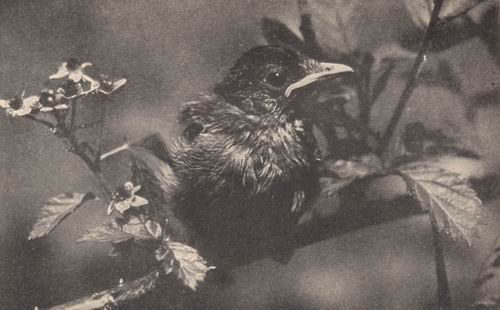
Like “Brer Rabbit” the catbird is usually “bred en bawn in a brier patch.”
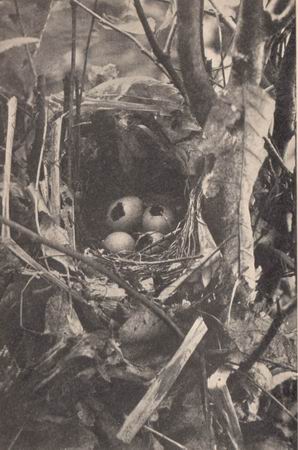
Another tragedy of the nests: what villain ate the catbird's eggs? With characteristic energy, he frequently begins to carry twigs into the house before he finds a mate. The day little jenny Wren appears on the scene, how he does sing! Dashing off for more twigs, but stopping to sing to her every other minute, he helps furnish the cottage quickly, but, of course, he overdoes -- he carries in more twigs and hay and feathers than the little house can hold, then pulls half of them out again. Jenny gathers too, for she is a bustling housewife and arranges matters with neatness and despatch. Neither vermin nor dirt will she tolerate within her well-kept home. Everything she does to suit herself pleases her ardent little lover. He applauds her with song; he flies about after her with a nervous desire to protect; he seems beside himself with happiness. Let any one pass too near his best beloved, and he begins to chatter excitedly: "Chit-chit-chit-chit” as much as to say, "Oh, do go away; go quickly! Can't you see how nervous and fidgety you make me?" If you fancy that jenny Wren, who is patiently sitting on the little pinkish chocolate spotted eggs in the centre of her feather bed, is a demure, angelic creature, you have never seen her attack the sparrow, nearly twice her size, that dares put his impudent head inside her door. Oh, how she flies at him! How she chatters and scolds! What a plucky little shrew she is, after all! Her piercing, chattering, scolding notes are fairly hissed into his ears until he is thankful enough to escape.
If the bluebirds had her courage and hot, quick temper, they would never let the sparrows drive them away from their boxes. Unfortunately a hole large enough to admit a bluebird will easily admit those grasping monopolists; but Jenny Wren is safe, if she did but know it, in her house with its tiny front door. It is amusing to see a sparrow try to work his shoulders through the small hole of an empty wren house, pushing and kicking madly, but all in vain. What rent do the wrens pay for their little houses? No man is clever enough to estimate the vast numbers of insects on your place that they destroy. They eat nothing else, which is the chief reason why they are so lively and excitable. Unable to soar after flying insects because of their short, round wings, they keep, as a rule, rather close to the ground which their finely barred brown feathers so closely match. Whether hunting for grubs in the wood-pile, scrambling over the brush heap after spiders, searching among the trees to provide a dinner for their large families, Or creeping, like little feathered mice, in queer nooks and crannies among the outbuildings on the farm, they are always busy in your interest which is also theirs. It certainly pays, in every sense, to encourage wrens.
THE CAROLINA WREN
The house wrens have a tiny cousin, a mite of a bird, called the winter wren, that is so shy and retiring you will probably never become well acquainted with it. It delights in mossy, rocky woods near running water. But a larger chestnut brown cousin, the Carolina wren, with a prominent white eyebrow, a bird which is quite common in the Middle and Southern States, sometimes nests in outbuildings and in all sorts of places about the farm. However, he too really prefers the forest undergrowths near water, fallen logs, half decayed stumps, and mossy rocks where insects lurk but cannot hide from his sharp, peering eyes. Now here, now there, appearing and disappearing, never at rest, even his expressive tail being in constant motion, he seems more nervously active than jenny Wren's fidgety husband. Some people call him the mocking wren, but I think he never deliberately tries to imitate other birds. Why should he? It is true that his loud-ringing, three-syllabled whistle, "Tea ket-tle, Tea-ket-tle, Tea-ket-tle," suggests the crested titmouse's "peto" of two syllables, but in quality only; and some have thought that his whistled notes are difficult to distinguish from the one-syllabled, but oft-repeated, long-drawn quoit of the cardinal. These three birds are frequently to be heard in the same neighbourhood. and you may easily compare their voices; but if you listen carefully, I think you will not accuse the wren of trying to mock either of the others. In addition to his ringing, whistled notes, he can make other sounds peculiarly his own: trills and quavers, scolding cacks, rattling kringggs, something like the tree toad's, besides the joyful, lyrical melody that has given him his reputation as a musician. Even these do not complete his repertoire. To deliver his famous song, he chooses a conspicuous position in the top of some bush or low tree; then, with head uplifted and tail drooping-a favourite posture of all these lively singers-he makes us very glad indeed that we heard him. Happily he sings almost as many months in the year as the most cheerful bird we have, the song sparrow.
THE MARSH WREN
Hidden among the tall grasses and reeds along the creeks and rivers, lives the long-billed marsh wren, a nervous, active little creature that you know at a glance. With tail cocked up and even tilted forward toward her head in the extreme of wren fashion, or suddenly jerked downward to help keep her balance, she sways with the grass as it blows in the wind -- a dainty little sprite. With no desire to make your acquaintance, she flies with a short, jerky motion (because of her short wings) a few rods away, then drops into the grasses which engulf her as surely as if she had dropped into the sea. You may search in vain to find her now. Like the rails, she has her paths and runways among the tall sedges and cat-tails, where not even a boy in rubber boots may safely follow. But she does not live alone. Withdraw, sit down quietly for awhile and wait for the excitement of your visit to subside; for every l member of the wren colony, peering sharply at you through the grasses, was watching you, long before you saw the first wren. Presently'' you hear a rippling, bubbling song from one of her neighbours; then another and another and still another from among the cat-tails which, ; you now suspect, conceal many musicians. The song goes off like a small explosion of melody whose force often carries the tiny singer up into the air. One explosion follows another, and between them there is much wren talk-a scolding chatter that is as great a relief to the birds' nervous energy as the exhaust from its safety valve is to a steam engine. The rising of a red-winged blackbird from his home in the sedges, the rattle of the kingfisher on his way up the creek, or the leisurely flapping of a bittern over the marshes is enough to start the chattering chorus. Why are the birds so excited? This is their nesting season, May, and really they are too busy to be bothered by visitors. Most birds are content to make one nest a year but not these, who, in their excess of wren energy, keep on building nest after nest in the vicinity of the one preferred for their chocolate brown eggs. Bending down the tips of the rushes they somehow manage to weave them, with the weeds and grasses they bring, into a bulky ball suspended between the rushes and firmly attached to them. In one side of this green grassy globe they leave an entrance through which to carry the finer grasses for the lining and the down from last season's bursted cat-tails. When a nest is finished, its entrance is often cleverly concealed. If there are several feet of water below the high and dry cradle, so much the better, think the wrens -- fewer enemies can get at them; but they do sometimes build in meadows that are merely damp. In such meadows the short-billed marsh wren, a slightly smaller sprite, prefers to live.
THE BROWN THRASHER
Called also: Brown Thrush; Long Thrush; Ground Thrush; Red Thrush; French Mocking-bird; Mavis. People who are not very well acquainted with the birds about them usually mistake the long-tailed brown thrasher for a thrush because he has a rusty back and a speckled white breast, which they seem to think is an exclusive thrush characteristic, which it certainly is not. The oven-bird and several members of the sparrow tribe, among other birds, have speckled and streaked breasts, too. The brown thrasher is considerably larger than a thrush and his habits are quite different. Watch him nervously twitch his long tail, or work it up and down like one end of a see-saw, or suddenly jerk it up erect while he sits at attention in the thicket, then droop it when, after mounting to a conspicuous perch, he lifts his head to sing, and you will probably "guess right the very first time" that he is a near relative of the wrens, not a thrush at all. As a little sailor-boy once said to me, "He carries his tell-tail on the stern." Like his cousin, the catbird, the brown thrasher likes to live in bushy thickets overgrown with vines. Here, running over the ground among the fallen leaves, he picks up with his long slender bill, worms, May beetles and scores of other kinds of insects that, but for him, would soon find their way to the garden, orchard, and fields. Yet few farmers ever thank him. Because they don't often see him picking up the insects in their cultivated land, they wrongly conclude that he does them no benefit, only mischief, because, occasionally, he does eat a little fruit. It seems to be a dreadful sin for a fellow in feathers to help himself to a strawberry or a cherry or a little grain now and then, although, having eaten quantities of insects that, but for him, would have destroyed them, who has earned a better right to a share of the profits? Do you think the brown thrasher looks any more like a cuckoo than he does like a thrush? Simply because he is nearly as long as the dull brownish cuckoo and has a brown back, though of quite a different tawny shade, some boys and girls say it is difficult to tell the two birds apart. The cuckoo glides through the air as easily as if he were floating down stream, whereas the thrasher's flight, like the wren's, is tilting, uneven, flapping, and often jerky. If you make good use of your sharp eyes, you will be able to tell many birds by their flight alone, long before you can see the colour of their feathers. The passive cuckoo has no speckles on his light breast, and the yellow-billed cuckoo, at least, has white thumb-nail spots on his well-behaved tail, which he never thrashes, twitches, and balances as the active, suspicious thrasher does his. Moreover the cuckoo's notes sound like a tree-toad's rattle, while the thrasher's song -- a merry peal of music -- entrances every listener. He seems rather proud of it, to tell the truth, for although at other times he may keep himself concealed among the shrubbery, when about to sing, he chooses a conspicuous perch as if to attract attention to his truly brilliant performance. The thrasher has been called a ground "thrush" because it so often chooses to place its nest at the roots of tall weeds in an open field; but a low bush frequently suits it quite as well. Its bulky nest is not a very choice piece of architecture. Twigs, leaves, vine tendrils, and bits of bark form its walls, and the speckled, greenish blue eggs within are usually laid upon a lining of fine black rootlets.
THE CATBIRD
Slim, lithe, elegant, dainty, the catbird, as he runs lightly over the lawn or hunts among the shrubbery, appears to be a fine gentleman among his kind-a sort of Beau Brummel in smooth, gray feathers who has preened and prinked until his toilet is quite faultless. You would not be surprised to hear that he slept on rose petals and manicured his claws. He is among the first to discover the bathing dish or drinking pan that you have set up in your garden, for he is not too squeamish, in spite of his fine appearance, to drink from his bath. With well-poised, black-capped head erect, and tail up too, wren fashion, he stands at attention on the rim of the dish, alert, listening, tense -- the neatest, trimmest figure in birddom. After he has flown off to the nearest thicket, what a change suddenly comes over him! Can it be the same bird? With puffed out, ruffled feathers, hanging head, and drooping tail, he now suggests a fat, tousled schoolboy, just tumbled out of bed. Was ever a bird more contradictory? One minute, from the depths of the bushy undergrowth where he loves to hide, he delights you with the sweetest of songs, not loud like the brown thrasher's, but similar; only it is more exquisitely finished, and rippling. "Prut! Prut! coquillicot!" he begins. "Really, really, coquillicot! Hey, coquillicot.! Hey, victory!" his inimitable song goes on like a rollicking recitative. The next minute you would gladly stop your ears when he utters the disagreeable cat-call that has given him his name. "Zeay, Zeay" -- whines the petulant cry. Now you see him on the ground calmly looking for grasshoppers, or daintily helping himself to a morsel from the dog's plate at the kitchen door. Suddenly, with a jerk and a jump, he has sprung into the air to seize a passing moth. There is always the pleasure of variety and the unexpected about the catbird. He is very intelligent and friendly, like his cousin, the mockingbird. One catbird that comes to visit me at least ten times every day, can scarcely wait for the milk to be poured into the dog's bowl before he has flown to the brim for the first drink. Once, in his eagerness, he alighted on the pitcher in my hand. He has a pretty trick of flying to the sun dial as if he wished to learn the time of day. From this point of vantage, he will sail off suddenly, like a flycatcher, to seize an insect on the wing. He has a keen appetite for so many pests of the garden and orchard-moths, grasshoppers, beetles, caterpillars, spiders, flies and other insects-that his friendship, you see, is well worth cultivating. Five catbirds, whose diet was carefully watched by scientific men in Washington, ate thirty grasshoppers each for one meal. Yet how many people ignorantly abuse the catbird! Because he has the good taste to like strawberries and cherries as well as we do, is he to be condemned on that account? If he kills insects for us every waking hour from April to October, don't you think he is entitled to a little fruit in June? The ox that treadeth out the corn is not to be muzzled, so that he cannot have a taste of it, you remember. A good way to protect our strawberry patches and cherry trees from catbirds, mockingbirds, and robins, is to provide fruit that they like much better the red mulberry. Nothing attracts so many birds to a place. A mulberry tree in the chicken yard provides a very popular restaurant, not only for the song birds among the branches, but for the scratchers on the ground floor. Like the yellow-breasted chat, the catbird likes to hide its nest in a tangle of cat brier along the roadside undergrowth and in bushy, woodland thickets. Last winter, when that vicious vine had lost every leaf, I counted in it eighteen catbird nests within a quarter of a mile along a country lane. Long before the first snowstorm, the inmates of those nests were enjoying summer weather again from the Gulf States to Panama. If one nest should be disturbed in May or June, when the birds are raising their families, all the catbird neighbours join in the outcry of mews and cat-calls. Should a disaster happen to the parents, the orphans will receive food and care from some devoted foster-mother until they are able to fly. You see catbirds are something far better than intelligent, musical dandies. THE MOCKINGBIRD What child is there who does not know the mockingbird, caged or free? In the North you very rarely see one now-a-days behind prison bars, for, happily, several enlightened states have made laws to punish people who keep our wild birds in cages or offer them for sale, dead or alive. When all the states make and enforce similar laws, there will be an end to the barbaric slaughter of many birds for no more worthy end than the trimming of hats for thoughtless girls and women. Birds of bright plumage have suffered most, of course, but the mockingbirds' nests have been robbed for so many generations to furnish caged fledglings for both American and European bird dealers, that shot guns could have done no work more deadly. Where the people are too ignorant to understand what mockingbirds are doing for them every day in the year by eating insects in their gardens, fields, parks, and public squares, they are shot in great numbers for the sole offence of helping themselves to a small fraction of the very fruit they have helped to preserve. Even the birds ought to have a "square deal" in free America: don't you think so? Although not afflicted with "the fatal gift of beauty," at least not the gaudy kind, like the cardinal's and scarlet tanager's, the mockingbird's wonderful voice has brought upon him an equal quantity of troubles. Keenly intelligent though he is, he does not know enough to mope and refuse to sing in a cage, but whiles away the tedious hours of his captivity by all manner of amusing and delightful sounds. Indeed it has been found that the household pet is apt to be a better mocker than the wild bird a most unfortunate discovery. Not only does he imitate the notes of birds about him, but he invents all manner of quips and vocal jugglery. His love song is entrancing. "Oft in the stilly night, " when the moonlight sheds a silvery radiance about every sleeping creature, the mockingbird sings to his mate such delicious music as only the European nightingale can rival. Perhaps the. stillness of the hour, the beauty and fragrance of the place where the singer is hidden among the orange blossoms or magnolia, increase the magic of his almost pathetically sweet voice; but surely there is no lovelier sound in nature on this side of the sea. Our poet Lanier declared that this " heavenly bird" will be hailed as "Brother" by Beethoven and Keats when he enters the choir invisible in the spirit world. Ever alert, on the qui vive, the mockingbird can no more suppress the music within him, night or day, than he can keep his nervous, high-strung body at rest. From his restlessness alone you might know he is the cousin of the catbird and brown thrasher and is closely related to the wrens. Flitting from perch to perch (fluttering is one of his chief amusements even in a cage), taking short flights from tree to tree, and so displaying the white signals on his wings and tail, hopping lightly, swiftly, gracefully over the ground, bounding into the air, or the next minute shooting his ashy gray body far across the garden and leaving a wake of music behind as he flies, he seems to be perpetually in motion. If you live in the South you can encourage no more delightful neighbour than this star performer in the group of lively singers.
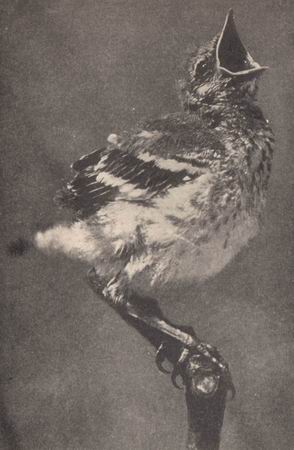
"MAMMA!" Young mockingbird calling for breakfast
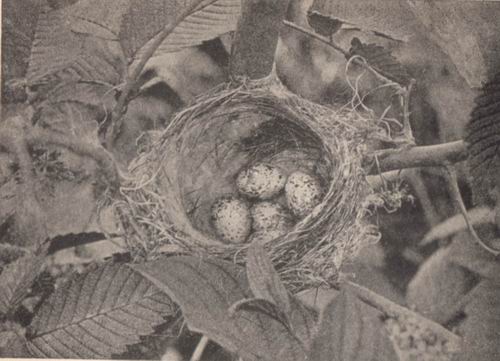
All is well with this yellow warbler's nest
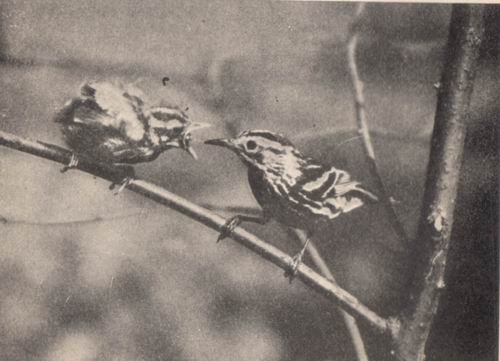
Dinner for one: a black-and-white warbler feeding her baby |